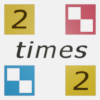Introduction to the Hangul Writing System
The korean script is known as Hangul. It consists of Jamo (letters) grouped into syllable blocks.
This page will teach you the basics of the Hangul writing system. To learn to write the jamo and memorise
them, we suggest using our Learn Hangul app.
Basic Jamo
There are 24 basic Jamo (14 consonants, and 10 vowels).
| Jamo | ㄱ | ㄴ | ㄷ | ㄹ | ㅁ | ㅂ | ㅅ | ㅇ | ㅈ | ㅊ | ㅋ | ㅌ | ㅍ | ㅎ |
|---|---|---|---|---|---|---|---|---|---|---|---|---|---|---|
| Romanisation | g | n | d | r | m | b | s | j | ch | k | t | p | h |
The romanisation shown in the table and used throughout this page is formed using the "Revised Romanization of Korean" system. This romanisation represents the corresponding Hangul sound adequately for the beginner to quickly grasp an initial understanding of the pronunciation.
| Jamo | ㅏ | ㅑ | ㅓ | ㅕ | ㅗ | ㅛ | ㅜ | ㅠ | ㅣ | ㅡ |
|---|---|---|---|---|---|---|---|---|---|---|
| Romanisation | a | ya | eo | yeo | o | yo | u | yu | eu | i |
Digraph Jamo
In addition to the basic 24 jamo, there are also 16 double letter Jamo (5 double consonants and 11 digraph vowels).
| Jamo | ㄲ | ㄸ | ㅃ | ㅆ | ㅉ |
|---|---|---|---|---|---|
| Romanisation | kk | tt | pp | ss | jj |
The digraph vowels are formed by just combining two of the basic vowels.
| Jamo | ㅐ | ㅒ | ㅔ | ㅖ | ㅘ | ㅙ | ㅚ | ㅝ | ㅞ | ㅟ | ㅢ |
|---|---|---|---|---|---|---|---|---|---|---|---|
| Romanisation | ae | yae | e | ye | wa | wae | oe | wo | we | wi | ui |
Stroke Order
Stroke order in hangul generally takes a left to right and a top to bottom approach. The same is true for the order
of the jamo within a syllable block.
The stroke order for the consonants is shown below along with the names for the consonants and the romanisation sound.
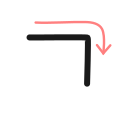
g
giyeok (기역)
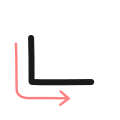
n
nieun (니은)
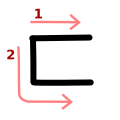
d
digeut (디귿)
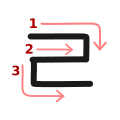
r
rieul (리을)
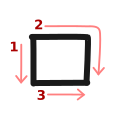
m
mieum (미음)
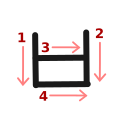
b
bieup (비읍)
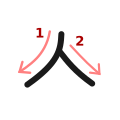
s
siot (시옷)
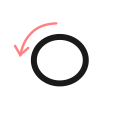
silent
ieung (이응)
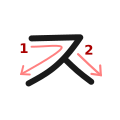
j
jieut (지읒)
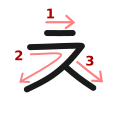
ch
chieut (치읓)
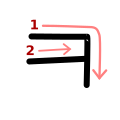
k
kieuk (키읔)
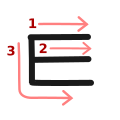
t
tieut (티읕)
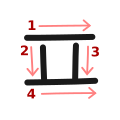
p
pieup (피읖)
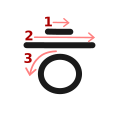
h
hieuh (히읗)
How jamo appears can depend on font and position in a syllable block. Whilst most changes are subtle and easily recognisable, there are two jamo, the j(ㅈ) and ch(ㅊ) consonants, which the beginner needs to pay attention to. For both these consonants, the long horizontal and subsequent sweeping stroke are usually merged into one when writing, and this is the stroke arrangement shown above.
The stroke order for the basic vowels is as follows:
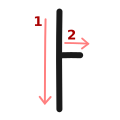
a
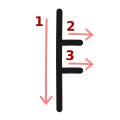
ya
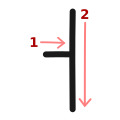
eo
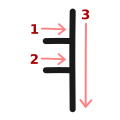
yeo
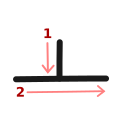
o
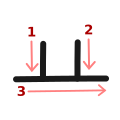
yo
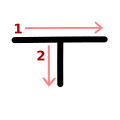
u
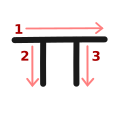
yu
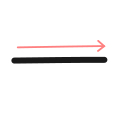
eu
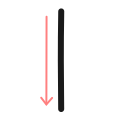
i
For digraph jamo, the same stroke orders as above are used for each jamo. The jamo on the left being written first.
Syllable Blocks
With knowledge of these 40 symbols, they can be arranged into syllable blocks with a few simple rules. Every syllable block starts with a consonant, double consonant, or the silent consonant placeholder, ㅇ. Every syllable block has a vowel, or digraph vowel, and this will dictate the arrangement of the block.For vowels with a main horizontal stroke (ㅗ, ㅛ, ㅜ, ㅠ & ㅡ), the vowel is placed below the initial consonant.
| Initial Consonant(s) |
| Vowel (ㅗ, ㅛ, ㅜ, ㅠ or ㅡ) |
For vowels with a main vertical stroke (ㅏ, ㅑ , ㅓ, ㅕ, ㅣ), and also digraph vowels with both vowels having a main vertical stroke (ㅐ, ㅒ, ㅔ, ㅖ), the vowel or digraph vowel is placed to the right of the initial consonant.
| Initial Consonant(s) | Vowel (ㅏ, ㅑ , ㅓ, ㅕ, ㅣ,ㅐ, ㅒ, ㅔ or ㅖ) |
For digraph vowels that combine both a vowel with a main horizontal stroke and a main vertical stroke (ㅘ, ㅙ, ㅚ, ㅝ, ㅞ, ㅟ, ㅢ), they wrap around the initial consonant:
| Initial Consonant(s) | |
| Digraph Vowel (part 1) | Digraph Vowel (part 2) |
Jamo Combinations
With 10 basic vowels and 19 consonants, we have 190 different combinations possible, which are all shown in the table below. Each row has a different consonant, and each column a different vowel. For the romanisation of each syllable block, just combine the row & column romanisations. For example, ㄱ (g) + ㅏ (a) = 가 (ga).
| a | ya | eo | yeo | o | yo | u | yu | eu | i | ||
|---|---|---|---|---|---|---|---|---|---|---|---|
| ㅏ | ㅑ | ㅓ | ㅕ | ㅗ | ㅛ | ㅜ | ㅠ | ㅡ | ㅣ | ||
| g | ㄱ | 가 | 갸 | 거 | 겨 | 고 | 교 | 구 | 규 | 그 | 기 |
| n | ㄴ | 나 | 냐 | 너 | 녀 | 노 | 뇨 | 누 | 뉴 | 느 | 니 |
| d | ㄷ | 다 | 댜 | 더 | 뎌 | 도 | 됴 | 두 | 듀 | 드 | 디 |
| r | ㄹ | 라 | 랴 | 러 | 려 | 로 | 료 | 루 | 류 | 르 | 리 |
| m | ㅁ | 마 | 먀 | 머 | 며 | 모 | 묘 | 무 | 뮤 | 므 | 미 |
| b | ㅂ | 바 | 뱌 | 버 | 벼 | 보 | 뵤 | 부 | 뷰 | 브 | 비 |
| s | ㅅ | 사 | 샤 | 서 | 셔 | 소 | 쇼 | 수 | 슈 | 스 | 시 |
| ㅇ | 아 | 야 | 어 | 여 | 오 | 요 | 우 | 유 | 으 | 이 | |
| j | ㅈ | 자 | 쟈 | 저 | 져 | 조 | 죠 | 주 | 쥬 | 즈 | 지 |
| ch | ㅊ | 차 | 챠 | 처 | 쳐 | 초 | 쵸 | 추 | 츄 | 츠 | 치 |
| k | ㅋ | 카 | 캬 | 커 | 켜 | 코 | 쿄 | 쿠 | 큐 | 크 | 키 |
| t | ㅌ | 타 | 탸 | 터 | 텨 | 토 | 툐 | 투 | 튜 | 트 | 티 |
| p | ㅍ | 파 | 퍄 | 퍼 | 펴 | 포 | 표 | 푸 | 퓨 | 프 | 피 |
| h | ㅎ | 하 | 햐 | 허 | 혀 | 호 | 효 | 후 | 휴 | 흐 | 히 |
| kk | ㄲ | 까 | 꺄 | 꺼 | 껴 | 꼬 | 꾜 | 꾸 | 뀨 | 끄 | 끼 |
| tt | ㄸ | 따 | 땨 | 떠 | 뗘 | 또 | 뚀 | 뚜 | 뜌 | 뜨 | 띠 |
| pp | ㅃ | 빠 | 뺘 | 뻐 | 뼈 | 뽀 | 뾰 | 뿌 | 쀼 | 쁘 | 삐 |
| ss | ㅆ | 싸 | 쌰 | 써 | 쎠 | 쏘 | 쑈 | 쑤 | 쓔 | 쓰 | 씨 |
| jj | ㅉ | 짜 | 쨔 | 쩌 | 쪄 | 쪼 | 쬬 | 쭈 | 쮸 | 쯔 | 찌 |
With the 11 digraph vowels combined with the consonants, we have a further 209 combinations, shown in the following table.
| ae | yae | e | ye | wa | wae | oe | wo | we | wi | ui | ||
|---|---|---|---|---|---|---|---|---|---|---|---|---|
| ㅐ | ㅒ | ㅔ | ㅖ | ㅘ | ㅙ | ㅚ | ㅝ | ㅞ | ㅟ | ㅢ | ||
| g | ㄱ | 개 | 걔 | 게 | 계 | 과 | 괘 | 괴 | 궈 | 궤 | 귀 | 긔 |
| n | ㄴ | 내 | 냬 | 네 | 녜 | 놔 | 놰 | 뇌 | 눠 | 눼 | 뉘 | 늬 |
| d | ㄷ | 내 | 댸 | 데 | 뎨 | 돠 | 돼 | 되 | 둬 | 뒈 | 뒤 | 듸 |
| r | ㄹ | 래 | 럐 | 레 | 례 | 롸 | 뢔 | 뢰 | 뤄 | 뤠 | 뤼 | 릐 |
| m | ㅁ | 매 | 먜 | 메 | 몌 | 뫄 | 뫠 | 뫼 | 뭐 | 뭬 | 뮈 | 믜 |
| b | ㅂ | 배 | 뱨 | 베 | 볘 | 봐 | 봬 | 뵈 | 붜 | 붸 | 뷔 | 븨 |
| s | ㅅ | 새 | 섀 | 세 | 셰 | 솨 | 쇄 | 쇠 | 숴 | 쉐 | 쉬 | 싀 |
| ㅇ | 애 | 얘 | 에 | 예 | 와 | 왜 | 외 | 워 | 웨 | 위 | 의 | |
| j | ㅈ | 재 | 쟤 | 제 | 졔 | 좌 | 좨 | 죄 | 줘 | 줴 | 쥐 | 즤 |
| ch | ㅊ | 채 | 챼 | 체 | 쳬 | 촤 | 쵀 | 최 | 춰 | 췌 | 취 | 츼 |
| k | ㅋ | 캐 | 컈 | 케 | 켸 | 콰 | 쾌 | 쾨 | 쿼 | 퀘 | 퀴 | 킈 |
| t | ㅌ | 태 | 턔 | 테 | 톄 | 톼 | 퇘 | 퇴 | 퉈 | 퉤 | 튀 | 틔 |
| p | ㅍ | 패 | 퍠 | 페 | 폐 | 퐈 | 퐤 | 푀 | 풔 | 풰 | 퓌 | 픠 |
| h | ㅎ | 해 | 햬 | 헤 | 혜 | 화 | 홰 | 회 | 훠 | 훼 | 휘 | 희 |
| kk | ㄲ | 깨 | 꺠 | 께 | 꼐 | 꽈 | 꽤 | 꾀 | 꿔 | 꿰 | 뀌 | 끠 |
| tt | ㄸ | 때 | 떄 | 떼 | 뗴 | 똬 | 뙈 | 뙤 | 뚸 | 뛔 | 뛰 | 띄 |
| pp | ㅃ | 빼 | 뺴 | 뻬 | 뼤 | 뽜 | 뽸 | 뾔 | 뿨 | 쀄 | 쀠 | 쁴 |
| ss | ㅆ | 쌔 | 썌 | 쎄 | 쎼 | 쏴 | 쐐 | 쐬 | 쒀 | 쒜 | 쒸 | 씌 |
| jj | ㅉ | 째 | 쨰 | 쩨 | 쪠 | 쫘 | 쫴 | 쬐 | 쭤 | 쮀 | 쮜 | 쯰 |
Jamo Syllable blocks can also have a final consonant(s), which are known as Batchim, and there are 27 possible such finals, which when combined with the 399 jamo in the above tables, we get another 10773 possible combinations, which i am not putting into a table.
Batchim
The batchim consists of one or more jamo that are placed below the preceding consonant-vowel combination. Batchim means to support, and from its position in the syllable block it is seen to be supporting the initial and medial jamo from below. For blocks with batchim, we have 3 possible arrangements:| Initial Consonant(s) | Initial Consonant(s) | Vowel (ㅏ, ㅑ , ㅓ, ㅕ, ㅣ,ㅐ, ㅒ, ㅔ or ㅖ) | Initial Consonant(s) | |||
| Vowel (ㅗ, ㅛ, ㅜ, ㅠ or ㅡ) | Digraph Vowel (part 1) | Digraph Vowel (part 2) | ||||
| Batchim | Batchim | Batchim | ||||
The jamo used for the final consonant are not of the same set as those used for the initial consonant. Whilst some consonants remain the same, some are not used and some have pronunciation changes. There is also a new set of 11 digraph consonants that can be used for the batchim.
Initial consonants also used as final consonants: ㄱ ㄲ ㄴ ㄷ ㄹ ㅁ ㅂ ㅅ ㅆ ㅇ ㅈ ㅊ ㅋ ㅌ ㅍ ㅎ
Additional digraph final consonants: ㄳ ㄵ ㄶ ㄺ ㄻ ㄼ ㄽ ㄾ ㄿ ㅀ ㅄ
The pronunciation of the batchim is not as straightforward as for the initial consonant and vowel. The final consonants will change pronunciation based on the following syllable block's initial consonant.
The stroke order of all the batchim are the same as for the initial consonant jamo shown earlier, and when multiple jamo are used in the batchim, they are written left to right.
